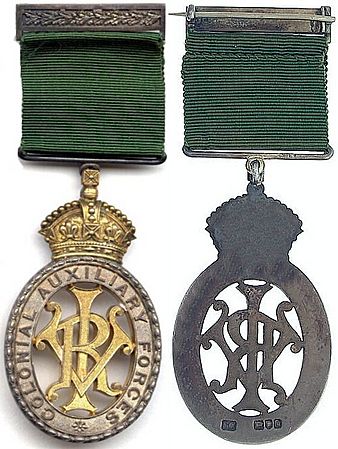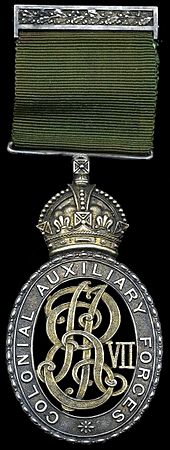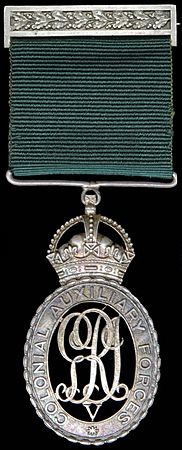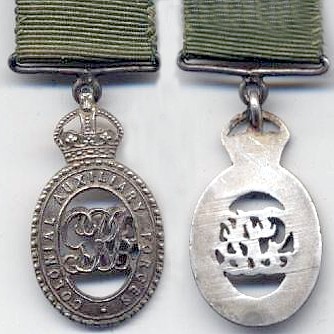Colonial Auxiliary Forces Officers' Decoration facts for kids
Quick facts for kids Colonial Auxiliary Forces Officers' Decoration |
|
|---|---|
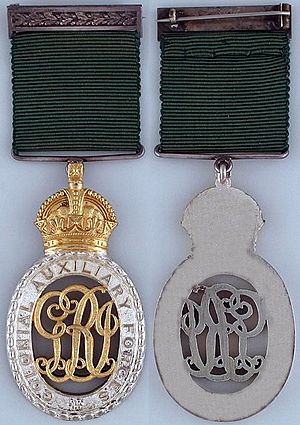
The first version of the medal for King George V, with a 32 mm ribbon.
|
|
| Country | |
| Type | Military long service decoration |
| Eligibility | Officers of part-time Colonial Forces |
| Awarded for | Twenty years of excellent service |
| Status | No longer awarded after 1930 |
| Post-nominals | VD |
| Statistics | |
| Established | 1899 |
| Order of wear | |
| Next (higher) | Volunteer Long Service Medal for India and the Colonies |
| Equivalent | Indian Volunteer Forces Officers' Decoration |
| Next (lower) | Colonial Auxiliary Forces Long Service Medal |
| Related | Volunteer Officers' Decoration |
The 32 mm and 38 mm ribbon bars |
|
The Colonial Auxiliary Forces Officers' Decoration was a special award given to military officers in the British Empire. The letters VD could be put after an officer's name to show they had received this honor. It was created in 1899 to thank officers who served for a long time in the part-time armies of Britain's colonies, dependencies, and protectorates.
This award replaced an older medal, the Volunteer Officers' Decoration for India and the Colonies, in most places except for the Indian Empire.
In 1930, this decoration was stopped. A new award called the Efficiency Decoration was created to honor part-time officers across the entire British Empire in a more standard way.
Contents
Why Was the Decoration Created?
Back in 1892, the United Kingdom created the Volunteer Officers' Decoration. It was for officers in Britain's own Volunteer Force who had served for a long time with great skill. Two years later, in 1894, the British government decided to give this award to volunteer officers all over the British Empire. This included places like India, Canada, and other Crown Colonies.
To do this, they made a new, separate medal called the Volunteer Officers' Decoration for India and the Colonies.
A New Medal for the Colonies
On May 18, 1899, Queen Victoria approved the creation of the Colonial Auxiliary Forces Officers' Decoration. This medal was for part-time officers who showed long and excellent service in the military forces of Britain's colonies. These forces were sometimes called militias or volunteers.
This new medal replaced the older one in all the colonies, but not in India. India later created its own special medal for its volunteer officers.
In 1925, it was officially approved for officers who received this decoration to use the letters VD after their names.
Who Could Get the Award?
To earn the Colonial Auxiliary Forces Officers' Decoration, an officer had to serve for 20 years in the part-time military forces of a British colony.
- An officer could combine service from different colonies to reach the 20-year requirement.
- Service in the military forces of the United Kingdom also counted. However, at least half of the service had to be in a colony.
- Service on the West Coast of Africa was considered very difficult, so each year served there counted as two years.
- Half of the time a person served as a regular soldier before becoming an officer could also be counted.
How the Decoration Was Worn
There is a special order for wearing medals. The Colonial Auxiliary Forces Officers' Decoration was worn after the Volunteer Long Service Medal for India and the Colonies but before the Colonial Auxiliary Forces Long Service Medal.
- Worn after the Volunteer Long Service Medal for India and the Colonies.
- Worn before the Colonial Auxiliary Forces Long Service Medal.
What the Decoration Looked Like
The decoration was an oval shape made of silver. It had a hollow, skeletal design. The medal was about 3.6 cm tall and 3.2 cm wide. It hung from a silver bar.
Front Side
The front of the medal has a silver oval band with the words "COLONIAL AUXILIARY FORCES" written on it. In the center, it features the Royal Cypher (the monarch's initials) in silver-gilt. An Imperial Crown, also in silver-gilt, sits on top. There were five different versions of the medal, one for each monarch.
- Queen Victoria's version (1899) had her initials "VRI" in the center.
- King Edward VII's version (after 1901) had his initials "ERI VII".
- King George V's first version (after 1910) had his initials "GRI".
- King George V's second version had "GRI V", with the Roman numeral "V" below the initials.
- King George V's third version had "GRI V", with the "V" to the right of the initials.
Back Side
The back of the medal was plain. The name of the person who received it was usually engraved on the back.
Ribbon
The ribbon was dark green and 3.2 cm wide. It was attached to a silver pin decorated with an oak leaf design. For a short time, from 1921 to 1927, the ribbon was made wider (3.8 cm), but it was later changed back to the original size.
End of the Decoration
On September 23, 1930, the Colonial Auxiliary Forces Officers' Decoration was discontinued. It was replaced by the Efficiency Decoration. This new medal was created to have one single award for the long and excellent service of part-time officers throughout the British Empire.


